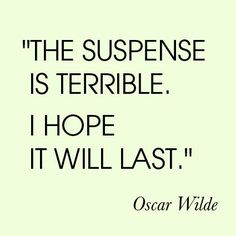Your Cart is Empty
Services
How to Build Suspense in Your Writing

Guest post by author @TevisShkodra. Originally published at tevisshkodra.com.
3 practical tips to keeping readers engaged
You’ve all heard the ageless adage of “Show, Don’t tell,” and if you’ve heard of it, chances are you’ve rolled your eyes and squinted at the ambiguity of the advice.
There are times when it is beneficial in your work to draw out a scene, to show the character’s completing the actions and to have them react to situations. If done right, readers following along will follow the rhythms of your characters; they’ll feel angry when the protagonist is angry, sad when he is sad.
 However, while showing vs. telling is crucial to building suspense in your work, it is something that will be underlying throughout your stories and novels.
However, while showing vs. telling is crucial to building suspense in your work, it is something that will be underlying throughout your stories and novels.
Tension, on the other hand, and the building of it as a plot device, is a much more digestible concept. Tension can happen in your story in a variety of different ways.
-
The reader knows something that the character does not —> Think of Hitchcock’s example (Found here), where there’s a bomb under the table. The bomb exploding causes surprise. Surprise is temporary - 15 seconds of shock.
However, if the reader knows about the bomb that the characters do not, you draw out this tension over several pages, keeping the reader in suspense of what will happen.
-
One character knows something the other character does not —> This also is a powerful device. The reader is, in many ways, an omniscient figure to the story. They can read the thoughts of different characters, and as a reader privy to the protagonist’s deepest thoughts, you begin to form an opinion on how that protagonist views the world around them.
Once you know a protagonist’s ulterior motives, you are drawn to the (seemingly) surface level conversations they have with others, as the reader will always be looking to see how those motives manifest.
- Another important source of suspense, and the essence of storytelling itself: Conflict. Creating conflict has been the make-or-break it factor of any story. Stories that fail to do that are put aside by readers, whereas stories that excel at conflict cannot be put down.
By understanding more about the character’s backstory (their motives), we raise the stakes. We become invested. Suspense is then created when we put obstacles in the way of the character' achieving these goals. This creates conflict.
How will the protagonist overcome this conflict? How will they prevail? If at all . . . This uncertainty is what keeps readers engaged.
(TL;DR) To summarize:
-
Showing, Not Telling leads to a higher level of empathy and engagement felt by the reader toward your characters. If you can show your characters in action, your reader will feel more invested in them.
-
You can create Tension in one of two ways: having readers know something the characters do not, or having the protagonist know something the others do not
-
Create Conflictby asking yourself first what your character wants to achieve, and then by placing a series of obstacles in their way of achieving it.
Editor's note: Tevis runs our How to Write Short Stories online Workshop. Check it out here.
Photo by Victoria Heath on Unsplash
2 Responses
dsfasd
June 12, 2020
you forgot number 3. It’s annoying not seeing “3.”. Keep that in mind. Overall nice article, a little short.
Leave a comment
Comments will be approved before showing up.
Also in So You Want to Write? Blog

How to Leverage Social Media for Effective Book Marketing
August 29, 2024 5 min read
Harness the power of these digital spaces to build a strong author brand, engage with audiences, and ultimately achieve literary success.
Read More
The 6 Basics In Your Successful Query Letter
July 12, 2024 5 min read
You did it, you’ve written your book. First of all, congratulations! Hopefully we will see it on store shelves very soon. The path to getting your book published can be daunting, and one of the key steps is mastering the art of the query letter. This letter is your introduction to literary agents and publishers, offering a snapshot of your book and a taste of your writing style. Your query letter is the key that can open the door to your publishing dreams.
In this article, we will explore five basic elements of a successful query letter that’ll give you the best chance of getting that book published.

9 Ways to Market Your First Book
May 30, 2024 6 min read
Have you ever wondered why some first-time authors gain a lot of attention while others don't? The secret often lies in how well they market their books.
For new authors, getting the hang of marketing can make a big difference. Having a solid plan to promote your book can really boost its success.
Write and Finish Your Book
Publish Your Book

The Writers' Roundtable
New 10-week group program led by award-winning and best selling author Alisha Sevigny.
Up to 20 writers can join to learn from her experience as an author, editor, and former literary agent.
PRICE: $350 USD
EARLY BIRD: $300 USD (until September 30th)



















Michael Pietrzak
June 12, 2020
Thanks dsfasd (if that is your real name!), I fixed it.